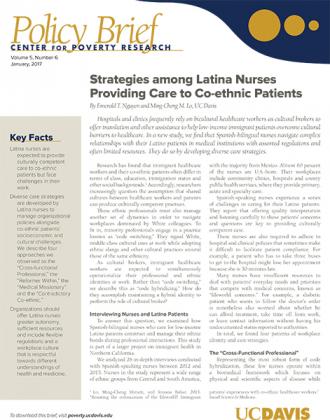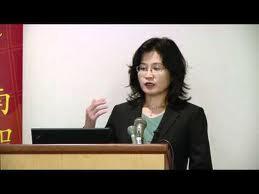Strategies among Latina Nurses Providing Care to Co-ethnic Patients
By Emerald T. Nguyen and Ming-Cheng M. Lo, UC Davis
Hospitals and clinics frequently rely on bicultural healthcare workers as cultural brokers to offer translation and other assistance to help low-income immigrant patients overcome cultural barriers to healthcare. In a new study, we find that Spanish-bilingual nurses navigate complex relationships with their Latino patients in medical institutions with assorted regulations and often limited resources. They do so by developing diverse care strategies.
Research has found that immigrant healthcare workers and their co-ethnic patients often differ in terms of class, education, immigration status and other social backgrounds.[1] Accordingly, researchers increasingly question the assumption that shared cultures between healthcare workers and patients can produce culturally competent practices.
Key Facts
- Latina nurses are expected to provide culturally competent care to co-ethnic patients but face challenges in their work.
- Diverse care strategies are developed by Latina nurses to manage organizational policies alongside co-ethnic patients’ socioeconomic and cultural challenges. We describe four approaches we observed as the “Cross-functional Professional,” the “Reformer Within,” the “Medical Missionary” and the “Contradictory Co-ethnic.”
- Organizations should offer Latina nurses greater autonomy, sufficient resources and include flexible regulations and a workplace culture that is respectful towards different understandings of health and medicine.
These ethnic professionals must also manage another set of dynamics in order to navigate workplaces dominated by White colleagues. To fit in, minority professionals engage in a practice known as “code switching.” They signal White, middle-class cultural cues at work while adopting ethnic slangs and other cultural practices around those of the same ethnicity.
As cultural brokers, immigrant healthcare workers are expected to simultaneously operationalize their professional and ethnic identities at work. Rather than “code switching,” we describe this as “code hybridizing.” How do they accomplish maintaining a hybrid identity to perform the role of cultural broker?
Interviewing Nurses and Latino Patients
To answer this question, we examined how Spanish-bilingual nurses who care for low-income Latino patients construct and manage their ethnic bonds during professional interactions. This study is part of a larger project on immigrant health in Northern California.
We analyzed 26 in-depth interviews conducted with Spanish-speaking nurses between 2012 and 2013. Nurses in the study represent a wide range of ethnic groups from Central and South America, with the majority from Mexico. Almost 60 percent of the nurses are U.S.-born. Their workplaces include community clinics, hospitals and county public health services, where they provide primary, acute and specialty care.
Spanish-speaking nurses experience a series of challenges in caring for their Latino patients. They report that offering quality interpretation and listening carefully to these patients’ concerns and questions are key to providing culturally competent care.
These nurses are also required to adhere to hospital and clinical policies that sometimes make it difficult to facilitate patient compliance. For example, a patient who has to take three buses to get to the hospital might lose her appointment because she is 30 minutes late.
Many nurses have insufficient resources to deal with patients’ everyday needs and priorities that compete with medical concerns, known as “lifeworld concerns.” For example, a diabetic patient who wants to follow the doctor’s order is nonetheless also worried about whether he can afford treatment, take time off from work, or leave contact information without having his undocumented status reported to authorities.
In total, we found four patterns of workplace identity and care strategies.
The “Cross-Functional Professional”
Representing the most robust form of code hybridization, these few nurses operate within a biomedical framework which focuses on physical and scientific aspects of disease while downplaying patient’s cultural understandings or emotional experiences—a framework that dominates contemporary U.S. medical institutions. Meanwhile, they acknowledge and address concerns that may pose a challenge to patients’ receiving quality care.
For example, Reyna,[2] an oncology RN, supports her patients and their families when they want time and space for prayer. She sympathizes with families who “need to take care of themselves by taking care of their loved one,” and, bends hospital regulations (with her colleagues’ support) to allow extra family members to stay overnight in the hospital room.
She also connects her patients with resources such as gift cards or food vouchers. She also emphasizes how important it is to show respect towards patients’ usage of herbs, as long as it seems harmless, which she believes helps her when, on occasion, she needs to tell them to stop using alternative medicines.
Nurses like Reyna only become cross-functional professionals if they enjoy strong institutional support, such as adequate resources, autonomy over work schedules, and a workplace culture that supports their unconventional practices.
The “Reformer Within”
These nurses also emphasize incorporating patients’ lifeworld concerns into clinical interactions, but they lack institutional support. On their own, they attempt to reform clinical norms in small but meaningful ways.
Yolanda, a 52 year-old Mexican public health nurse, describes deviating from a doctor’s instructions at the risk of reprimand. After pleading without success with a pediatrician for a more flexible regimen for the patient’s family, Yolanda told the patient’s parents, “We can do it his [the doctor’s] way. Or we can do it the way that you will find more comfortable or that you know you can accomplish. The goal is to make it successful for your son.”
Nurses like Yolanda foster relational or even pseudo-familial bonds with their patients. These relationships allow the Latina nurses and patients alike to empower each other. While these nurses prioritize relationships over institutional norms, these nurses individually bear the cost through extra work, time-management difficulties, colleagues’ disapproval or becoming physically and emotionally burned out.
The “Medical Missionary”
A few Latina nurses in this study fully endorse the scientific superiority of biomedicine and the rationality of clinical procedures. They embrace ethnic bonds with Latino patients only to help them assimilate into the world of modern medicine.
Unlike the Cross-Functional Professional or Reformer Within, the Medical Missionary does not incorporate patients’ life experiences into medical interactions. These nurses view co-ethnic patients’ “failure” to assimilate as the patient’s choice.
For example, two nurses, Xena and Beatrice, both describe patients’ lifeworld concerns as “excuses” for noncompliance. They believe that when patients deviate from clinical norms, it means they do not really want to be helped. In these instances, these nurses will not offer to patients anything “out of the scope of what we do.”
The “Contradictory Co-ethnic”
The majority of the nurses in this study find it rewarding to serve co-ethnic patients, but also feel pressured to adhere to a professional universalism of providing “color-blind” care. They sympathize with co-ethnic patients’ lifeworld concerns but lack adequate institutional support to solve them.
Nurses like Nancy acknowledge that Latino patients have a cultural tendency to engage in “story-telling” when a simple ‘yes’ or ‘no’ answer would do. While she admits that she can sometimes get frustrated by patients’ inability to answer questions directly, Nancy hopes that she is not “one of those people that gets exasperated and cuts them off.”
These nurses are confronted by different groups—physicians, fellow nurses, and patients—demanding them to demonstrate whether their loyalty lies more with their professional or ethnic identity. They experience high workplace stress from multiple competing priorities.
Reducing Health Disparities
The policy implications from these findings are clear: having Latina nurses serve as an intermediary between physicians and co-ethnic patients is not a silver bullet to solve the larger problem of healthcare disparities between Latinos and non-Latinos.
Rather, Latina nurses are best able to fulfill their bi-cultural functions—not just as nurse translators, but also as holistic caregivers—when institutions give nurses greater autonomy, sufficient resources and include flexible regulations and a workplace culture that is respectful towards different understandings of health and medicine. When expected to perform the role of cultural brokers without such institutional support, many Latina nurses end up bearing the cost, material or otherwise, on their own.
Emerald Nguyen received her Ph.D. in sociology at UC Davis.
Ming-Cheng M. Lo is a professor of sociology at UC Davis.
[1] Lo, Ming-Cheng Miriam, and Roxana Bahar. 2013. “Resisting the colonization of the lifeworld? Immigrant patients’ experiences with co-ethnic healthcare workers.” Social Science & Medicine.
[2] The names of the subjects in this brief are pseudonyms.
#povertyresearch












